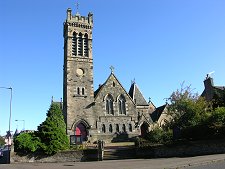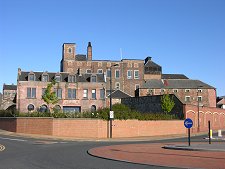 Mill Street and the Old Burgh Chambers |
Alloa is the main town serving Scotland's smallest local authority area, Clackmannanshire. It lies on the north bank of the River Forth, some six miles east of Stirling and two miles west of Clackmannan.
The town grew up here largely because of the presence of Alloa Tower. The lands north of this stretch of the River Forth were granted by the Scottish Crown to Sir Robert Erskine in about 1360. His successors were made Earls of Mar and it was the Erskine family who first built a castle here, at the end of the 1300s or the beginning of the 1400s.
The Alloa Tower you see today was built in the late 1400s, probably incorporating parts of its predecessor. It was visited by Mary Queen of Scots and her son, James VI, received some of his education here. The tower is a truly massive construction, four storeys tall and with walls 11ft thick. But it is only a small part of what once stood here. In the early 1700s a large mansion was built that incorporated the tower, and extensive gardens were also established. The result was one of the most impressive palaces in Scotland.
But the grand house caught fire in 1800 and only the tower itself could be saved. The tower was extensively restored prior to being opened to the public in 1996. (Continues below images...)
 Alloa Town Hall |
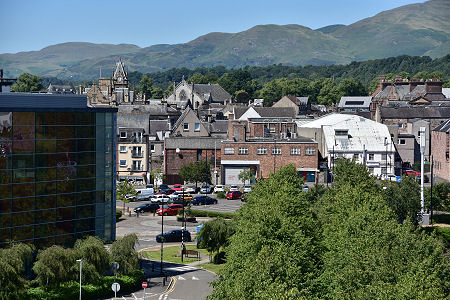 Alloa Seen from the Roof of Alloa Tower |
A ferry across the River Forth had operated between what later became Alloa and South Alloa since early medieval times. Under the Earls of Mar, Alloa also began to develop as a significant harbour and trading port. The trade through the port grew dramatically once coal began to be mined in the area. In 1710, the Custom House that oversaw all the upper Forth ports was built in Alloa; and Glasgow merchants then built warehouses here to hold sugar and tobacco intended for re-export to the continent.
By the mid 1800s, 2,000 vessels were using the docks at Alloa and 175,000 tonnes of coal were exported each year. Meanwhile, ships of up to 100ft in length were also being built here. In 1885 a railway bridge was built across the Forth to the west of Alloa. The columns still stand but the bridge itself has since been demolished. The rail bridge temporarily put the ferries out of business, but they resumed operation in 1901 and a vehicle ferry was introduced on the route from 1924.
The ferries finally ceased operation in 1939, though traffic had been in steep decline since the opening of the Kincardine Bridge to the east in 1936. By the 1960s the Port of Alloa could not compete with modern handling techniques at ports like Grangemouth, and even its shipbreaking operations were too far upriver to be reached by the larger ships then being scrapped. The port closed in 1970 and Alloa has since largely turned its back on its river frontage, save for some new housing development and a small area of the shore given over to riverside relaxation.
Today's Alloa is a busy and diverse town with a fine collection of impressive buildings that reflect the considerable wealth generated by a strong industrial and trading past.
Despite this, the centre of Alloa retains little from the early years of its development. There was an old town dating back to the 1700s, but much of it was swept away to allow the building of the vast Kilncraigs worsted-spinning mill in the 1800s, while the rest disappeared under Maclay's Thistle Brewery, built in the 1870s. Much of Kilncraigs Mill has itself now gone, to make way for car parks and a supermarket: though part of what remains has been attractively redeveloped as council offices.
Meanwhile, Maclay's Thistle Brewery ceased brewing in 1999, and has been demolished to make way for flats and retail units. In 1900, breweries operating in Alloa included Bass, Caponcroft, Forth, Forthbank, Hutton Park, Meadow, Mills, Shore, Thistle and Townhead, as well as the better known George Younger's Candleriggs Brewery and Arrol's Alloa Brewery. There are rather fewer in operation in the town now.
On a more positive note, a railway station has reopened in Alloa, allowing rail journeys to be made to Stirling - and all points beyond - for the first time in many years.
 High Street |
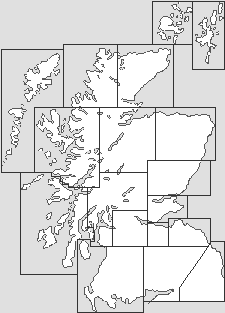
|
|
|
Visitor InformationView Location on MapWhat3Words Location: ///patrolled.declares.tilt |
 Roundabout Art, "Lifeline" |
 Mar Street |
 Maple Court |
 Spiers Centre Registry Office |
 Sculpture by Walter Awlson |
 St Mungo's RC Church |
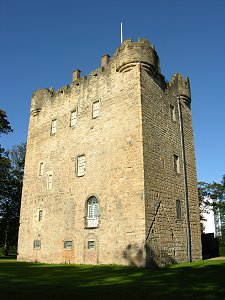 Alloa Tower |
 Greenside Street |
 War Memorial |
 Crest on Old Burgh Chambers |
 The Shore |


